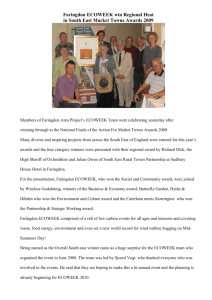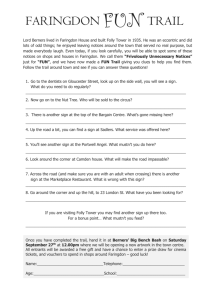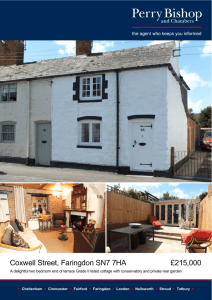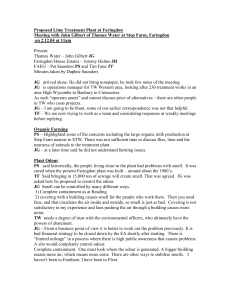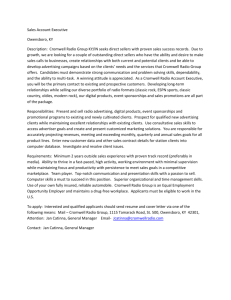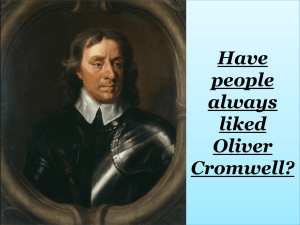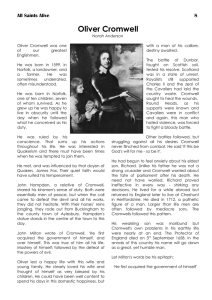Civil war History
advertisement
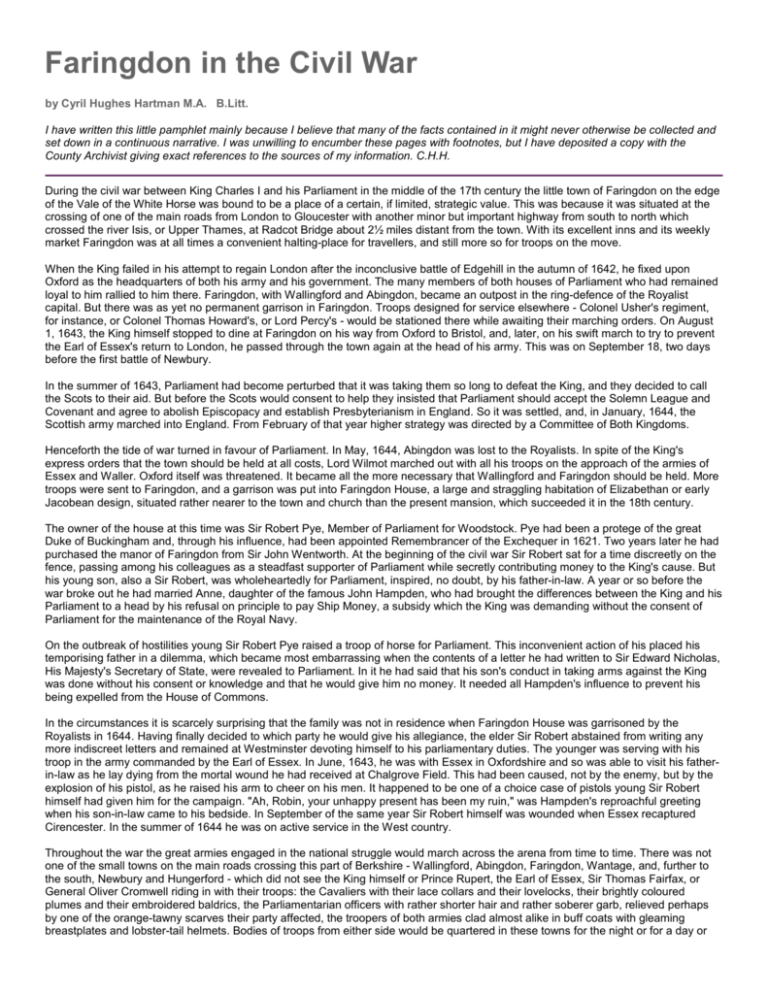
Faringdon in the Civil War by Cyril Hughes Hartman M.A. B.Litt. I have written this little pamphlet mainly because I believe that many of the facts contained in it might never otherwise be collected and set down in a continuous narrative. I was unwilling to encumber these pages with footnotes, but I have deposited a copy with the County Archivist giving exact references to the sources of my information. C.H.H. During the civil war between King Charles I and his Parliament in the middle of the 17th century the little town of Faringdon on the edge of the Vale of the White Horse was bound to be a place of a certain, if limited, strategic value. This was because it was situated at the crossing of one of the main roads from London to Gloucester with another minor but important highway from south to north which crossed the river Isis, or Upper Thames, at Radcot Bridge about 2½ miles distant from the town. With its excellent inns and its weekly market Faringdon was at all times a convenient halting-place for travellers, and still more so for troops on the move. When the King failed in his attempt to regain London after the inconclusive battle of Edgehill in the autumn of 1642, he fixed upon Oxford as the headquarters of both his army and his government. The many members of both houses of Parliament who had remained loyal to him rallied to him there. Faringdon, with Wallingford and Abingdon, became an outpost in the ring-defence of the Royalist capital. But there was as yet no permanent garrison in Faringdon. Troops designed for service elsewhere - Colonel Usher's regiment, for instance, or Colonel Thomas Howard's, or Lord Percy's - would be stationed there while awaiting their marching orders. On August 1, 1643, the King himself stopped to dine at Faringdon on his way from Oxford to Bristol, and, later, on his swift march to try to prevent the Earl of Essex's return to London, he passed through the town again at the head of his army. This was on September 18, two days before the first battle of Newbury. In the summer of 1643, Parliament had become perturbed that it was taking them so long to defeat the King, and they decided to call the Scots to their aid. But before the Scots would consent to help they insisted that Parliament should accept the Solemn League and Covenant and agree to abolish Episcopacy and establish Presbyterianism in England. So it was settled, and, in January, 1644, the Scottish army marched into England. From February of that year higher strategy was directed by a Committee of Both Kingdoms. Henceforth the tide of war turned in favour of Parliament. In May, 1644, Abingdon was lost to the Royalists. In spite of the King's express orders that the town should be held at all costs, Lord Wilmot marched out with all his troops on the approach of the armies of Essex and Waller. Oxford itself was threatened. It became all the more necessary that Wallingford and Faringdon should be held. More troops were sent to Faringdon, and a garrison was put into Faringdon House, a large and straggling habitation of Elizabethan or early Jacobean design, situated rather nearer to the town and church than the present mansion, which succeeded it in the 18th century. The owner of the house at this time was Sir Robert Pye, Member of Parliament for Woodstock. Pye had been a protege of the great Duke of Buckingham and, through his influence, had been appointed Remembrancer of the Exchequer in 1621. Two years later he had purchased the manor of Faringdon from Sir John Wentworth. At the beginning of the civil war Sir Robert sat for a time discreetly on the fence, passing among his colleagues as a steadfast supporter of Parliament while secretly contributing money to the King's cause. But his young son, also a Sir Robert, was wholeheartedly for Parliament, inspired, no doubt, by his father-in-law. A year or so before the war broke out he had married Anne, daughter of the famous John Hampden, who had brought the differences between the King and his Parliament to a head by his refusal on principle to pay Ship Money, a subsidy which the King was demanding without the consent of Parliament for the maintenance of the Royal Navy. On the outbreak of hostilities young Sir Robert Pye raised a troop of horse for Parliament. This inconvenient action of his placed his temporising father in a dilemma, which became most embarrassing when the contents of a letter he had written to Sir Edward Nicholas, His Majesty's Secretary of State, were revealed to Parliament. In it he had said that his son's conduct in taking arms against the King was done without his consent or knowledge and that he would give him no money. It needed all Hampden's influence to prevent his being expelled from the House of Commons. In the circumstances it is scarcely surprising that the family was not in residence when Faringdon House was garrisoned by the Royalists in 1644. Having finally decided to which party he would give his allegiance, the elder Sir Robert abstained from writing any more indiscreet letters and remained at Westminster devoting himself to his parliamentary duties. The younger was serving with his troop in the army commanded by the Earl of Essex. In June, 1643, he was with Essex in Oxfordshire and so was able to visit his fatherin-law as he lay dying from the mortal wound he had received at Chalgrove Field. This had been caused, not by the enemy, but by the explosion of his pistol, as he raised his arm to cheer on his men. It happened to be one of a choice case of pistols young Sir Robert himself had given him for the campaign. "Ah, Robin, your unhappy present has been my ruin," was Hampden's reproachful greeting when his son-in-law came to his bedside. In September of the same year Sir Robert himself was wounded when Essex recaptured Cirencester. In the summer of 1644 he was on active service in the West country. Throughout the war the great armies engaged in the national struggle would march across the arena from time to time. There was not one of the small towns on the main roads crossing this part of Berkshire - Wallingford, Abingdon, Faringdon, Wantage, and, further to the south, Newbury and Hungerford - which did not see the King himself or Prince Rupert, the Earl of Essex, Sir Thomas Fairfax, or General Oliver Cromwell riding in with their troops: the Cavaliers with their lace collars and their lovelocks, their brightly coloured plumes and their embroidered baldrics, the Parliamentarian officers with rather shorter hair and rather soberer garb, relieved perhaps by one of the orange-tawny scarves their party affected, the troopers of both armies clad almost alike in buff coats with gleaming breastplates and lobster-tail helmets. Bodies of troops from either side would be quartered in these towns for the night or for a day or two, unwelcome always to their inhabitants, for they rarely left without doing some damage or committing some outrage. The godly Roundheads had an insatiable urge to destroy any ancient monuments that were adorned with what they considered to be idolatrous images of angels, saints, or mitred abbots, or of the Virgin Mary, in particular. It was they who, for this reason, pulled down the Market Crosses in both Abingdon and Wantage. The Royalists, on the other hand, who were ill paid and had to live off the land, would raid and plunder the lofts and larders, the beer-cellars and hen-roosts of their unwilling but helpless hosts, and leave without paying a penny for their entertainment. And all the time a miniature civil war was being carried on in these parts. The Parliamentarian Governor of Abingdon never possessed quite enough troops to try to take Faringdon or Wallingford unaided. Nor could the Royalist Governors of those places lay siege to Abingdon for exactly the same reason. But they did their utmost to harry one another incessantly by patrolling all the highways to intercept reinforcements or stop convoys of arms or supplies of provisions. At intervals they would make swift and sudden raids on one another's territories. This kind of local warfare on a minor scale is, of course, a feature of all civil wars. In this part of Berkshire and the adjacent districts in Oxfordshire, Gloucestershire, and Wiltshire, small towns, villages, and even private houses were often self-contained little fortresses, sometimes even isolated in areas dominated by the enemy. And, above all, bridges, such as Radcot Bridge and New Bridge, were always of vital interest and importance to both parties and were constantly changing hands, often only for a matter of hours or even minutes, if a party stronger or more numerous than the defenders forced a quick passage and pressed on their way. Two unknown soldiers (sine nomine corpora), slain in one of these unrecorded little skirmishes near Radcot in 1645, lie buried at Clanfield. Whichever party held Radcot Bridge would try also to occupy Radcot House, on the Oxfordshire side, and a field nearby, already conveniently entrenched in times long past - no one knows exactly when. This site is still known locally as the "Garrison". The story of Radcot Bridge is inseparably linked with that of Faringdon. On his way back to Oxford towards the end of November, 1644, the King halted overnight at Faringdon to consider where to quarter his horse, which had formerly been stationed at Abingdon and other places now in Parliamentary hands. He decided that henceforth Faringdon should be one of its headquarters, and appointed Colonel George Lisle Governor of the town and garrison. Lisle was a gallant soldier who had signally distinguished himself on many a battlefield. At the second battle of Newbury a few weeks before he had carried himself with reckless bravery, "having no armour on besides courage, and a good cause, and a good holland shirt." Lisle confessed to being disappointed at the condition in which he found Faringdon and complained to his close friend, Prince Rupert, that the town was but one third fortified and entirely unprovisioned. But he soon set about remedying the latter deficiency at least. On December 3O, 1644, Major-General Richard Browne, Governor of Abingdon, wrote to Parliament to complain of his activities: "I pray you to consider the prejudice we suffer by the new garrison at Faringdon, which stops all cattle and other provisions usually coming by that way, and which yet might be removed by an indifferent party, if I had soldiers to spare." But Browne had his revenge when a party of horse from Faringdon took part next month in an attack on Abingdon led by Sir Henry Gage, Governor of Oxford, with Prince Rupert and Prince Maurice. The task of the Faringdon contingent was to attack Browne's horse-quarters on one side of the town to distract attention from the main assault, which was to be made from the Culham side. The Faringdon horse was utterly routed and fled with the Roundheads in hot pursuit. According to Browne most of them were killed or taken prisoner "except some few, who escaped being pursued within a mile of Faringdon." Although the Presbyterians were still dominant in Parliament itself, they were now less powerful in the army than the Independents, of whom Oiver Cromwell was the leading spirit. And the Independents were at last successful in compelling the politicians to make changes in the high command. The self-denying Ordinance, suggested by Cromwell, enacted that henceforth no member of either house of Parliament should hold command in the armed forces. This meant the resignation of all their chief generals: the Earls of Essex and Manchester, Sir William Waller, the Earl of Warwick, who commanded the Navy, and, of course, Cromwell himself. But it is likely that Cromwell already had a shrewd notion of how that little difficulty could be overcome. Finally it was decided that all the Parliamentary forces should be reorganised in a New Model Army, of which Sir Thomas Fairfax should be in supreme command. At the beginning of April, 1645, Fairfax went to Windsor to begin preparations to take the field with the new army. Among those who came to bid him farewell on giving up their commands was Lieutenant-General Cromwell. But Fairfax had just had orders from the Committee of Both Kingdoms to send a body of horse to lie between Oxford and Worcester to prevent a junction between the King and Prince Rupert, and in his opinion Cromwell was exactly the right man for this task. Cromwell thought so, too. And so Fairfax applied for him to be allowed to keep his command for the time being. To this the Committee readily agreed. Accordingly Fairfax sent him off at once to co-operate with Major-General Browne in the reduction of the Oxford district. At the end of the month the Committee wrote to both the generals concerned to confirm this arrangement until further order. Cromwell was to command all the horse, and Browne all the foot. "We desire you," they wrote in almost identical letters to both, "by mutual correspondence and joint counsel to conduct those forces and to take the best advantages you can for opposing the enemy." For the rest of the war Cromwell continued to hold high command in the army, always on an allegedly temporary basis. On April 15 Cromwell met and defeated a strong body of Royalist cavalry under the young Earl of Northampton at Islip Bridge, north of Oxford. He took some 2OO prisoners and four colours, including the Queen's own standard "being a crown in the midst, incircled with divers Flower-de-Luces wrought in gold, with a golden cross on the top." The routed troops were pursued to Bletchington House, where they took refuge. Cromwell's summons to surrender the house was at first refused by the Governor, Colonel Francis Windebank, the son of a former Secretary of State. But by the cunning use of words of command shouted at a convenient distance from the house, Cromwell, whose force consisted only of cavalry, was able to deceive the defenders into thinking that he had a large body of foot to support him, and after only four hours the house was surrendered on terms. The garrison, which consisted of some 2OO men, was allowed to march out with the honours of war, but, on his arrival at Oxford, Colonel Windebank was tried by court martial and sentenced to be shot for cowardice. Windebank himself was by no means lacking in courage, but had been overcome by the tears and entreaties of his terrified young bride and other ladies at Bletchington. A last attempt to save him from death was made by Sir Henry Bard, the Royalist Governor of Campden House in Gloucestershire, who wrote to Prince Rupert: "The letter enclosed was sent to me from Oxford, to be conveyed with all speed possible. Pray God it comes time enough! It concerns a most unfortunate man, Colonel Windebank. Sir, pity him and reprieve him. It was God's judgment on him, and no cowardice of his own. At the battle of Alresford he gave a large testimony of his courage, and if with modesty I may bring in the witness, I saw it, and thence began our acquaintance. Oh, happy man had he ended then! Sir, let him but live to repair his honour, of which I know he is more sensible than are the damned of the pains of hell. And sure it will be a perfect means to his salvation. God and your Highness consult about it." This letter was written on April 28, but it was intercepted by the enemy and never reached Rupert. It is possible that he would have tried to save the luckless young man, for it was his intervention that had secured the reprieve of Colonel Fielding, who had surrendered Reading in 1643. But the Prince did not arrive in Oxford until May 4, the day after Windebank had been shot against Merton College wall. Cromwell decided that Bletchington was not worth holding and did not remain there long, but set off in a south-westerly direction towards Witney. On April 26 he heard that there was a body of Royalist horse before him and sent Colonel John Fiennes forward to attack it. Fiennes encountered it somewhere near Faringdon and put it to flight, taking 4O prisoners, a large number of horses and three colours, with the loss of only ten of his own men. This Royalist cavalry seems to have been part of a force sent from Faringdon to strengthen Woodstock againt Cromwell and forestall an attack by him. Their task accomplished, they were now returning to garrison. The 3OO foot in this party were under the command of Sir Richard Vaughan, and on April 27 Cromwell received information that they were not above three hours march in front of him. He immediately sent his "forlorn" in pursuit of them. The "forlorn", more properly called the "forlorn hope", was a small detachment of picked troops, usually volunteers, to which the most venturesome and perilous tasks in war were entrusted. Cromwell was noted for his frequent and judicious use of them. But he was not, of course, the originator of the "forlorn", which is of immemorial antiquity. In the Civil War the Royalists also prided themselves on the exploits of their "forlorns", and in May, 1643, the King had ordered "certain Badges of silver containing Our Royall Image and that of Our dearest Sonne Prince Charles to be delivered to weare on the breast of every man, who shall be certified under the hands of their Commanders-in-chiefs to have done us faithful service in the Forlorne hope." The English expression is the equivalent of the Dutch Verloren hoop or Verloren kinder, and the French Enfants perdus, and doubtless the Greeks had a word for it. The Royalists were overtaken by Cromwell's "forlorn" in the fields on the outskirts of Bampton in the Bush. A skirmish ensued in which most of the casualties on the Parliament side appear to have been horses. The Royalists were able to get into the town before Cromwell came up with his main body. They had put up a barricade and occupied a strongly-built house before his arrival at eleven o'clock that evening. They slighted his summons to surrender and resisted all attempts to storm their barricade during the night with "soe good resolution", in Cromwell's own words, that they could not be forced from it. He was obiged to wait till morning, when he sent a drum to them calling upon them once more to surrender. Their answer was that they would not do so unless they might march out upon honourable terms. Cromwell sternly replied that they must submit all to mercy. This they angrily rejected. He insisted and made preparations to storm the house. But first he sent them words "to desire them to deliver out the Gent and his family" - presumably the owners of the house. They must, he repeated, expect severity if they put him to a storm. They agreed to his demand, and after some further parleying, decided that the odds against them were too great and that they must, after all, yield to mercy. The 2OO survivors who surrendered included Sir Richard Vaughan himself, Lieutenant-Colonel Littleton, Major Lee, several more officers of lower rank, and a Doctor of Divinity, Vaughan's chaplain. The prisoners having been sent under escort to Abingdon, Cromwell held a council of war, at which it was agreed that the next step should be to reduce the remainder of the garrison at Faringdon. But as they had no foot, which would be needed for a siege, it was decided to send to Major-General Browne for assistance. Meanwhile Cromwell crossed the river Isis by Radcot Bridge, and on the evening of April 28 wrote a despatch to the Committee of Both Kingdoms giving them an account of the success of his campaign so far and informing them that he was now "quartered up to Faringdon." The exact location of Cromwell's horse-quarters at or near Faringdon is uncertain; but it seems likely that they were, as is traditionally supposed, somewhere on the slopes of Faringdon Hill, now known as Faringdon Folly. Although by this time he controlled the town itself, he would scarcely have placed himself within range or too easy reach of the defenders of Faringdon House, whereas from the higher ground he could not only command the town but also get a clear view of the roads that approached it from every direction. He could, therefore, anticipate any attack that might be made on him. Next morning he sent the following summons to Faringdon House: Sir, I summon you to deliver into my hands the house wherein you are, and your ammunition, with all things else there, together with your Persons to be disposed of as the Parliament shall appoint: which, if you refuse to do, you are to expect the utmost extremity of war. I rest your servant. April 29, 1645 O. Cromwell To the governour of the Garison in Farrington The Royalists replied with a message to the effect that the King had entrusted them to keep that garrison, and, without special order from His Majesty himself, they would not deliver it. On receiving this Cromwell sent another summons to the Governor: Sir, I understand by forty or fifty poor men whom you forced into your House that you have many there whom you cannot arm, and who are not serviceable to you. If these men should perish by your means, it were great Inhumanity. Surely Honour and Honesty requires this, that you be prodigal of your own Lives, yet not be so of theirs. If God gives you into my hands, I will not spare a Man of you, if you put me to a Storm. Oliver Cromwell. Colonel Lisle, the Governor, was not then in Faringdon, but a proud and defiant reply came from Colonel Burges, the officer commanding the garrison in the house: Sir, We have forced none into our Garison: we would have you know you are not now at Blechington. The guiltless Blood that shall be spilt God will require at your hands that have caused this Unnatural War. We fear not your Storming, nor will have any Parlies. Your servant Roger Burges In the course of the day some five or six hundred foot, all that Browne could spare from the garrison at Abingdon, marched into the town, and Cromwell decided to storm the house in the dark hours of that night. At three o'clock in the morning on April 3O the assault was begun. Supported by Cromwell and his troopers, the foot advanced with ladders and attempted to scale the walls. But when Captain Canon, who reared the first scaling-ladder and was himself the first to ascend it, was taken prisoner by the defenders with an ensign and eight troopers who followed him, this method of attack was promptly given up. After 14 men had been killed and several more of the besieging troops had been wounded, Cromwell decided that the attempt was too costly and abandoned it. Captain Jenkins of Pickering's regiment of foot, from the Abingdon contingent, was the only officer killed; but at least two of Cromwell's cavalry officers, Cornet George Scale and Quartermaster Richard Smith, both of Major-General Holborne's regiment of dragoons, were wounded in the assault. Cromwell made no further effort to take the house, although he remained at Faringdon for a few days longer. Meanwhile Sir Thomas Fairfax had been preparing to march into the West country with his whole army, except the troops under Cromwell's command. His chief object was to relieve beleaguered Taunton, which was reported to be in sore straits. But it was being stoutly defended by Colonel Robert Blake, later to attain wider fame as the greatest English admiral of his time, and might yet be saved. Parliament regarded the relief of Taunton as an urgent matter of prestige, since the town had always been well affected to its cause, though situated in the midst of country which was mainly loyal to the King. It had changed hands several times already. Taken by Parliament in 1642, it had been recaptured for the King in the following year, and then once more regained for Parliament by Sir Robert Pye and Colonel Blake in July, 1644. It was now being closely besieged by the Royalists. Fairfax started from Windsor on April 3O and on May 2 had reached Newbury. Cromwell rode over from Faringdon to meet him. While the two generals were talking, it was learnt through some Royalist prisoners who had been brought in that Lord Goring was in the neighbourhood of Hungerford or Marlborough with a strong cavalry force and that it was his intention to beat up Cromwell's horsequarters that very night or early next morning. Cromwell left Newbury at once and hastened back to Faringdon. On his arrival there he sent Major Bethel with a small party of horse to reinforce Radcot Bridge; but Bethel, apparently not realising that Goring had passed through Lechlade and was coming up along the north side of the river, ventured too far into Oxfordshire in the dark and was caught by the Royalists. Eighteen of his men were killed, and he himself was taken prisoner with four others. Goring then easily gained possession of the bridge. Cromwell himself decided to cross the Isis lower down at New Bridge in the hope of taking Goring in the rear. But Goring had astutely foreseen this move and was there to meet him. After the skirmish that followed, both sides seem to have been convinced that victory had been theirs. Cromwell was under the impression that Goring retired incontinently to Lechlade and thence into the West, whence he had come, whereas really he joined the King at Woodstock, as had been arranged. It was not until May 8 that he returned to Lechlade with a greatly augmented force of 2,5OO horse, having left the King on his way to Evesham the previous day. The Cavaliers, on the other hand, fondly thought that they had defeated Cromwell "with a great slaughter." Goring's victory, says Clarendon "gave him great reputation, and made him exceedingly welcome to the King." But Cromwell, though perhaps slightly battered, was not beaten. He had proceeded in good order to Abingdon. If he returned at all to Faringdon within the next day or two, it was only to move camp, for he now received orders to proceed to Bletchington, place a garrison in the house, and await the arrival of Fairfax, who had been hastily recalled. Since the King had left Oxford, Parliament considered that this would be a good opportunity to lay siege to the place and deprive him of his headquarters. Fairfax, who by now had reached Blandford in Dorset, was ordered to detach a brigade for the relief of Taunton and to return forthwith himself with the rest of his army to the neighbourhood of Oxford. The blockading of Oxford was begun about May 16. But on June 3 the army was ordered to abandon the siege and to march north to try to prevent the Royalists from taking Leicester. They arrived too late for that, but on June 14 they encountered the King at Naseby, where Fairfax, ably seconded by Cromwell, inflicted upon him a crushing defeat, which effectively ended all his hopes of final victory in the war. After the battle of Naseby Fairfax came south again. On Thursday, June 26 his army marched into Lechlade, where they were to be quartered for the night. The "forlorn" that had gone before to clear the way reported that they had surprised there some of the soldiers belonging to Radcot garrison, shot Lieutenant-Colonel Nott, and taken four prisoners. Nott, a Cavalier officer who had been most active in the district, seems to have been only wounded, for before the end of this year he was to reappear as a thorn in the side of the local Parliamentarian forces. Next day Fairfax was proceeding to Wanborough, but decided to pause on the way to reduce the Royalist stronghold at Highworth, which consisted of the church fortified by a line and bulwarks and garrisoned by less than a hundred men under Major Hen. The army sat down before the place, and a summons to surrender was sent to the Governor. On his refusing to yield, ordnance was planted and storming-parties were drawn up in readiness for an assault. A few shots appear to have been exchanged, for Fairfax lost four men, and there is a cannon-ball, still suspended in the Warneford chapel at Highworth church, which is supposed to have been fired at the church, leaving a considerable dent in the wall above the west door. But, in view of the very formidable preparations that were being made against him by an entire army, Major Hen decided to give in, and, hauling down what the Roundhead chronicler describes as his "bloody coulours", sounded a parley, and yielded upon quarter. The flag he was flying was probably the plain red flag of battle, known as the "Bloody Flag", like that flown on the maintopmast-head of the flagship in naval actions. Seventy prisoners and 8O firearms were taken, and the Puritan soldiers are reported to have had "good booty" in the church. Fairfax decided that the place had better be securely held for Parliament henceforth and ordered the Governor of Malmesbury to send a small garrison there to act as an outpost. On November 2O, 1645, it was reported that a party of Parliamentarian foot had occupied Lechlade. It was, in fact, a strong body under Captain William Moore, sent there by Colonel Nicholas Devereux, to prevent incursions into Wiltshire by the garrisons of Faringdon and Radcot. Devereux had also arranged with Colonel Morgan, commanding the Gloucestershire horse, that there should be a party of horse in the neighbourhood ready to act in support. Some of them were already there. But of this the Royalists were as yet unaware. On receiving the news that the enemy were at Lechlade, a party of 3O horse immediately set out from Radcot to prevent any attempt at fortifying the little town. In the brief skirmish that followed their coming the only combatant seriously injured was the Royalist commander, Captain Aytwood, who was shot through the thigh. Realising that they had underestimated the strength and numbers of the opposition, the Cavaliers retreated with a Parthian fusillade of curses, calling their foes damned rogues and promising to return soon with a larger party. When the news of this setback reached Faringdon it was arranged that Major Duett should attempt to take the enemy by surprise that very evening with an adequate force, consisting of 1OO foot and 15O horse. But when they arrived at seven o'clock they found that adequate preparations had also been made to receive them; for, as they entered the town, they were met by the flanking fire of 6O musketeers who had been concealed behind a wall. After an hour and a half's fighting in which six of their men were killed the Royalists were driven out of the town and retired in the direction of Radcot. But by this time the Gloucester horse had taken alarm. Half an hour later they rode into Lechlade in force and, joining with the foot, set off in pursuit of the retreating Cavaliers, whom they overtook close under the wall of Radcot House. There was some fierce fighting, in which the Roundheads were victorious. Major Duett himself and some 2O of his men were killed, and the 3O prisoners included a Cornet and five men belonging to the King's lifeguard. The spoils of war were 26 horses and 6O firearms. The Roundhead casualties were very slight. Two men only were wounded, and not mortally. At some time during these operations the notorious Lieutenant-Colonel Nott had also been captured. On sending him to London to be dealt with there, Colonel Devereux described him as "a most malevolent man ... who hath been as mischievous in his actions as Duett." The frequent forays of the Faringdon garrison were viewed with some alarm by the local commanders of Parliament forces. Colonel Devereux considered that another garrison should be placed between Faringdon and the Parliamentarian headquarters at Marlborough throughout the winter "to wait on the Farrington forces as they come abroad." And Colonel Dalbier, commanding at Newbury, was afraid that they might come abroad as far as there. On January 7, 1646, he wrote to the Committee of Berks, Bucks, and Oxon, pointing out the danger to be apprehended from the 3OO horse quartered at Faringdon. If they were to join with the horse from Wallingford and Donnington Castle and could procure the assistance of some foot, they could easily take Newbury. But his fears proved groundless, for the state of the King's affairs was far worse than he supposed. The authorities at Westminster were better informed of the situation. In the spring of 1646 the Committee of Both Kingdoms decided that the time had come to close in again on Oxford and, as a first step, to reduce its various outposts. On April 1O orders were sent to Colonel Sanderson to block up Radcot with troops from both Lechlade and Standlake in Oxfordshire. On the same day the Governor of Malmesbury received orders to send 3OO foot to block up Faringdon with the assistance of his garrison at Highworth. The King had realised by now that his cause was irretrievably lost, and on April 27 he left Oxford secretly with only two attendants and set out on his journey northwards to place himself in the hands of the Scots. Five days later Fairfax arrived before Oxford to conduct the final siege that was to end the war. On May 3 he surveyed the city from all angles and set his plans in motion. As soon as his dispositions were made he sent out forces for the blocking up of other garrisons, those outlying stations that had formed part of Oxford's defences. The party for Faringdon was placed under the command of Sir Robert Pye, while Colonel Cook was to lead a force to secure the passage over the river at Radcot Bridge. They proceeded to their assigned posts at once, and summonses for the surrender of these places were sent out on or about May 11. Colonel Sanderson seems to have been satisfied with merely blocking up the approaches to Radcot, for it was not until May 24, nearly a fortnight after the arrival of the reinforcements under Colonel Cook, that Radcot submitted. A grenade falling on the roof penetrated to the ground-floor and let out all the beer. Faced with this irreparable disaster, the hundred men who formed the garrison under Colonel Palmer decided to give in and, after handing over their arms, were allowed to disperse to their several homes. In the course of this brief siege the Roundheads lost only six men. Presumably the bridge was taken at the same time, if not before. But Faringdon still held out. The choice of Sir Robert Pye to go to Faringdon was an obvious one, for, besides being a native of the place and the son of the owner of the house to be besieged, he had by now had considerable experience of command in the field. In recognition of his previous services at Taunton and elsewhere he had been appointed Colonel of one of the regiments of horse in the New Model Army, and in May, 1645, had been sent north to assist the Scottish army. He was selected instead of Cromwell, whom the Scots disliked. On his way he had stopped to take charge of the defence of Leicester against the King's threatened attack. He was taken prisoner when Leicester fell and sent under safe conduct to London by Prince Rupert to arrange for his own exchange for Colonel George Monck or Colonel Sir Henry Tillyer. He was exchanged for Tillyer, but the formalities took some days, so that he missed being present at Naseby, where his regiment fought in the right wing under Cromwell. In September of the same year he had taken an active part in the reduction of Bristol. On his arrival in Faringdon, no doubt Sir Robert called upon the defenders of Faringdon House to surrender; but it seems rather unlikely that he made any really serious attempt to bombard or storm his father's home, which he himself expected to inherit in due course, especially as it soon became known that the Scots had prevailed upon the King to send orders for the surrender of Oxford and all his other garrisons on fair and honourable terms. That such was his intention was already known early in May, although the royal warrant requiring the Governors to surrender was not despatched from Newcastle-upon-Tyne until June 1O. The negotiations for the surrender of Oxford proceeded rather slowly, but were finally concluded on Saturday, June 2O, upon terms that were creditable to both sides. Article XXIV of the agreement ran as follows: "That the garrisons of Farringdon shall be rendered to his excellency Sir Thomas Fairfax, and the governor, gentlemen, soldiers, and all other of what quality soever with those garrisons, shall enjoy the benefit of these articles in every particular which may concern them, they rendering the garrison accordingly as Oxford." The capitulation was to be on June 24, and about ten o'clock in the morning of that day the garrison of Faringdon marched out under arms, with bag and baggage and with all the honours of war, leaving only their ordnance, ammunition, and stores of spare arms behind them. The reason why Faringdon was the only one of the outposts to be actually included in the Oxford Articles was that the Governor, who had been knighted and was now Sir George Lisle, happened to be in Oxford when the offer to capitulate arrived on June 2O and so was able in person to negotiate the surrender. Colonel Burges, who had so gallantly defended Faringdon House against Cromwell the year before, was also in Oxford. The officer commanding the garrison in the house at the time of the capitulation was Sir William Courtney. The often repeated, but quite unwarranted, statement that the Governor of Faringdon was another famous Cavalier soldier, Sir Marmaduke Rawdon probably derives from a misunderstanding of the only visible part of the inscription on a ledger stone now covered by a choir-stall in the church: Marmol hoc posuit Marmaduc Rawdon Armiger. (This stone was placed here by Marmaduke Rawdon, Esquire.) The slab may, of course, mark the grave of Sir Marmaduke Rawdon, Kt., (Marmaduc Rawdon Eques), placed there by a son or nephew, for Marmaduke was a favourite Christian name in the Rawdon family. And Sir Marmaduke may have met his death at Faringdon in the Civil War. But it is certain that he was never Governor. Faringdon has the distinction of being one of the last places to hold out for the King. Worcester and Wallingford stood fast for a few weeks longer, but, after their capitulation towards the end of July, there remained only a few isolated strongholds held by inveterate and irreconcilable loyalists. One by one these also were reduced. Pendennis Castle, in Cornwall, yielded on August 17, and two days later Raglan Castle, in Monmouthshire, was surrendered to Fairfax himself by the Dying Marquess of Worcester. With the departure of the Royalist garrison the war was ended so far as Faringdon was concerned. But the town had suffered much through fire and sword in the course of the hostilities, and the inhabitants, eager for redress, were disposed, perhaps not unnaturally, but, probably, quite unfairly, to place the whole blame on the defeated party. They sent a succession of petitions to Parliament, but, if they ever received any reparation, it must have been very tardy. In the Lords' Journals for September 2, 1648, over two years after the capitulation, there is the draft of an order for a collection to be made for the assistance of the inhabitants of Faringdon and Westbrook "in repairing the ruin caused to their habitations, goods, and church, which were demolished and burnt by the enemy's garrison; the damage has been assessed by able and substantial workmen at £56,976.4s. Od." They had petitioned for relief out of the estates of those who had been in the garrison. But these men, they said, had either fled beyond the reach of the law or else had been included in the Articles of Oxford and so could not be proceeded against. In piteous terms the "poor distressed inhabitants" told how they had had to depend upon the charity of the surrounding country. Many of them had long been homeless and hungry. They also complained that, "by the death of their late orthodox vicar they were destitute of food and aliment for their souls." There is a slight mystery here. The Vicar of Faringdon from 163O to 1661 was the Rev. John Mason, who was succeeded in the latter year by the Rev. Thomas Fowler. The "orthodox vicar" seems, therefore, to have been a minister installed by the Presbyterians while the true vicar was ejected. At any rate, the interloper was never recognized by the Church of England. The damage to the church had been serious. At some time during the war the steeple had been knocked off the tower by cannon-fire, and the top of the tower itself had been so shattered that it had to be reduced in height. The south aisle had been, at least partially, destroyed. It is obvious, too, that the monuments of the Unton family were irreparably damaged, whether wilfully or otherwise; for the present monuments seem to have been rather arbitrarily put together from what remained of the original ones, and the memorial tablet to Sir Henry Unton, erected in 16O6, has been set in a new framework of much later and more modest design (1658). Who was responsible for all this is a debatable point. Cannon-balls have been found in the churchyard, but these mute relics cannot tell when, from what direction, or by whom they were fired. The popular belief is that Faringdon's stunted church-tower is one of the ruins that Cromwell knocked about a bit. But it must be remembered that, in 1645, Cromwell was in command of a cavalry force, which was intended to be highly mobile, and it is most unlikely that he had any artillery with him when he came to Faringdon. Guns are not mentioned in his own account of the events at Bletchington and Bampton in the days immediately before. Some artillery may have been brought by the party of foot sent by Browne from Abingdon; but there is no hint of a preliminary bombardment in the account of the attempt to storm the house. It is always possible that the steeple was brought down, not by Cromwell, nor by Sir Robert Pye, but by the Royalists, firing from the house. It is known that there were four pieces of ordnance in the house when it was surrendered. The assertion of the inhabitants that it was the garrison that damaged the church cannot be wholly discounted. And even if Cromwell did procure guns from somewhere and there was an artillery duel, shots from both sides are equally liable to go wide of the mark. It should be realised that the effective range of a field-gun of those days would not be more than from two to four hundred yards and its "random" range not more than six hundred. At any rate, the main damage to the structure of the church may well have been inadvertent; it was not of a kind that either side would have inflicted deliberately. In the course of the years Faringdon gradually regained its former modest prosperity; and a traveller, Thomas Baskerville, in Charles II's reign, recorded that, though much of the town had been burnt in the Civil War, it was now pretty well built, with some good inns for entertainment, of which the Crown was chief. No doubt the Pyes, as Lords of the Manor, had contributed something towards its restoration. True to his principles, the younger Sir Robert supported the Protectorate and sat in both Cromwell's so-called parliaments. But he did not relish the military misrule in the troubled times that followed the death of Cromwell, and he was one of the many gentlemen sent to the Tower for presenting petitions in favour of the re-admission of the secluded members of the Long Parliament. Most of the others were hastily set free when it became known that General Monck was approaching London with a well-disciplined army, the goodwill of the country, and plans which, if not yet quite clear, were likely to be more honest and sensible than anything produced by the factious scheming of ambitious men that had prevailed during the past year. But Sir Robert Pye, who had applied for a writ of Habeas Corpus, which had been refused by a judge, was not let out until the House of Commons itself voted his release. Sir Robert was a member of the convention Parliament that called back the rightful king, but, after the Restoration, he took no further part in politics and retired to Faringdon. On his father's death in 1662 he succeeded to Faringdon House and for the rest of his long life dwelt there with his wife and family in quiet and dignified obscurity, emerging only to greet William of Orange on his triumphant progress to London in 1688. Both he and Lady Pye died in 17O1, "having lived together for sixty years in great reputation." Upon their tombstone, now half-concealed beneath an altar-step in the Pye Chapel in Faringdon church, it is also stated that Sir Robert Pye was "esteemed a fine gentleman by all who knew him." Faringdon is a quiet little place, set in a half-forgotten corner of that rural England, which as yet retains a meed of the timeless charm and beauty that once used to characterise the whole country. The town itself still possesses something of the unhurried atmosphere of a more leisured age, with its few streets but numerous narrow lanes and unexpected alleys, with its open archways that afford occasional glimpses of picturesque old courts or stableyards. Soon, no doubt, they will all be demolished in the frenzied endeavour to achieve the brash new world; but for the moment they are mercifully suffered to linger on. The town has rarely figured prominently in the pages of history. There was a royal residence here in Saxon times; in 1145 some sort of fort, grandiosely dignified by the name of castle, was built by Robert, Earl of Gloucester, and razed to the ground within the year by King Stephen; King John had thoughts of founding here a Cistercian monastery, which later, however, became a mere cell dependent on the great abbey of Beaulieu in Hampshire; in 1387 one of the many little battles for Radcot Bridge was fought when the revolting barons led by the Earl of Derby defeated Richard II's favourite, Robert de Vere, Earl of Oxford and Duke of Ireland. Robert de Vere is said to have escaped from the field of combat by discarding his armour and swimming across the river. Like all little towns situated on one of the great roads, Faringdon has had its share of passing visits from the reigning sovereign - Henry III and his queen, Elizabeth I, James I, and Charles I. Of Faringdonian notabilities there have been but few: Sir Henry Unton, the Elizabethan ambassador to France who challenged the Duc de Guise to a duel for the honour of his queen, three members of a family that once owned Faringdon House, Sir Robert Pye, the soldier of Parliament, Henry James Pye, an estimable man but an indifferent maker of verses, who was appointed Poet Laureate by the younger Pitt, Vice-Admiral Sir Thomas Pye, notorious for his enormous nose and his quite exceptional flair for securing undeserved promotion. Lastly, there was the late Lord Berners, a musician and composer of merit, who persisted, in spite of strong and heated opposition, in indulging the old-fashioned and aristocratic whim of erecting a handsome but entirely useless tower on the top of the hill already known as the Folly. Time has vindicated him, for the Folly tower has become the recognized symbol of Faringdon's dignity and a well-beloved landmark throughout the Vale. Faringdon's is not a very eventful story on the whole. But for a few brief years in the 17th century the little town was sometimes in the limelight and had the chance to show its mettle. There are few other places in the British isles that can make the proud boast that they resisted and repelled an attack from the redoubtable Oliver Cromwell.
